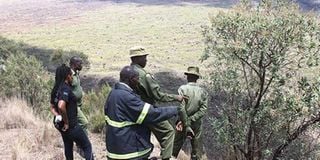Volcanic Menengai crater site turning into virtual death trap

Kenya Forest Service officers at the scene where a body was retrieved at Menengai crater on April 22, 2019. The tourism destination is slowly turning into a death trap. PHOTO | JOHN NJOROGE | NATION MEDIA GROUP
What you need to know:
- The site attracts thousands of visitors from across the globe.
- But lack of a barrier to prevent visitors from sliding into the deep abyss is a clear sign of abandonment.
- On May 6, 2003, Fr Michael Kabutu, drove into the crater, plunging to death.
Menengai crater in Nakuru County remains one of Kenya’s most intriguing tourism destinations.
But the crater, one of the largest in the world, appears to have turned into a death trap due to years of neglect by the national and county governments.
The site attracts thousands of visitors from across the globe.
But lack of a barrier to prevent visitors from sliding into the deep abyss is a clear sign of abandonment.
Visitors pay an entry fee at the main gate from where they proceed to the crater. But their safety is not assured.
NO FENCE
Residents say they have witnessed people and livestock plunge to their deaths as there is no fence around the crater.
“We have had cases in which our livestock have fallen into the crater. We call upon the county government to fence the area and erect guard rails to prevent further loss of lives,” a resident, Mr John Maina, told the Nation.
The crater, located seven kilometres north of Nakuru Town, draws visitors for all manner of reasons, ranging from site-seeing to educational tours, pilgrimage and even suicide.
People travel from as far as Uganda, western Kenya and the Coast to congregate in caves for prayers, while others, desperate and unhappy, occasionally throw themselves into the abyss.
BODY FOUND
In the most recent incident, police and the county government fire brigade last week retrieved the body of a man believed to have slid into the crater while touring the area.
The body was discovered by residents after a foul smell started emanating from the crater.
The body was trapped in a tree and it took the team three days to retrieve it due to the steepness of the crater.
This was just one of many tragic incidents at the crater.
The only warning visitors get of imminent danger is in the form of small notices at particular areas.
At the top, at a place named Viewpoint which is 2,300 metres above sea level, there is a huge signpost erected by the Rotary Club showing directions and distances in kilometres to several places around the world.
CATHOLIC PRIEST
The most notable suicide was on May 6, 2003, when a Catholic priest, Fr Michael Kabutu, drove into the crater, plunging to death.
Fr Kabutu, then 31, was alone in the vehicle when it veered off the crater’s rim and hurtled into the 485-metre abyss.
The priest had been suspended from his Mogotio Parish under circumstances that Archbishop Peter Kairu, who was then in charge of the diocese, was reluctant to reveal.
Fr Kabutu had been asked to go and reflect about his vocation — but he instead committed suicide.
RESCUED
In 2012, a man who was part of a group of students who had gone for a weekend adventure at the 2,272-metre-deep abyss, slid and fell into the crater.
He was rescued by the Nakuru Municipal Council fire brigade.
In 2015, a primary school teacher hired a boda boda from Nakuru town, paid the rider and, on reaching the crater, leapt to his death.
Nakuru County Tourism CEC Raymond Kome, in an interview with the Nation, said the county, stung by past cases of disaster in some of its major tourism sites, has embarked on a mission to boost safety and security of tourists.
Among the measures that the county wants to put in place include disaster response equipment at tourism sites — including lakes, gorges, hotels and other facilities.





